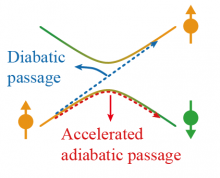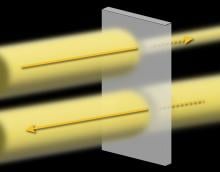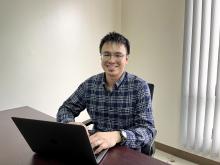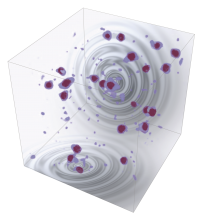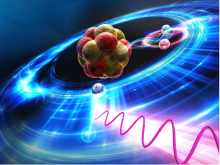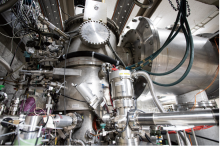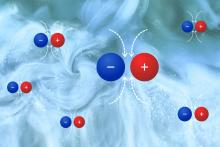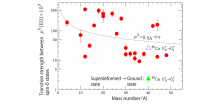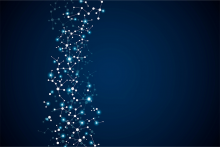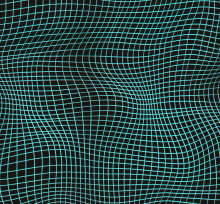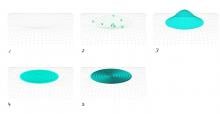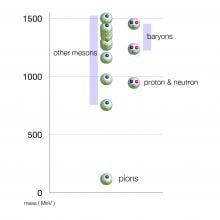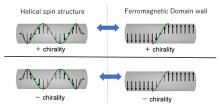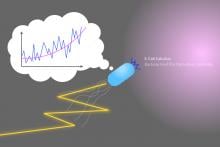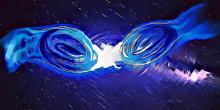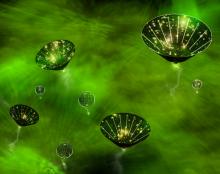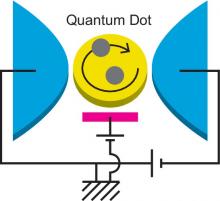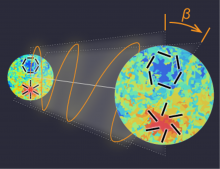Physical Review Letters
News
05 Mar 2024
SANKEN researchers achieved the acceleration of adiabatic evolution of a single spin qubit in gate-defined quantum dots for the first time. After the pulse optimization to suppress quasistatic noises, the spin flip fidelity can be as high as 97.5% in GaAs quantum dots. This work may be useful to achieve fast and high-fidelity quantum computing.
13 Feb 2024
Researchers from the Institute of Industrial Science, The University of Tokyo have solved a foundational problem in transmitting quantum information, which could dramatically enhance the utility of integrated circuits and quantum computing.
18 Jan 2024
A research group led by Osaka Metropolitan University has discovered significant nonreciprocal optical absorption of LiNiPO4, referred to as the optical diode effect, in which divalent nickel (Ni2+) ions are responsible for magnetism, by passing light at shortwave infrared wavelengths used in optical communications. Furthermore, they have uncovered that it is possible to switch the optical diode effect by applying a magnetic field. This is a step forward in the development of an innovative optical isolator that is more compact and can control light propagation, replacing the conventional optical isolators with complex structures
09 Aug 2023
A team led by researchers at Osaka University and University of California, San Diego has conducted simulations of creating matter solely from collisions of light particles. Their method circumvents what would otherwise be the intensity limitations of modern lasers and can be readily implemented by using presently available technology. This work might help experimentally test long-standing theories such as the Standard Model of particle physics, and possibly the need to revise them.
14 Jun 2023
A physicist from the University of the Philippines – Diliman College of Science National Institute of Physics (UPD-CS NIP) led a team of researchers in pioneering a way to make a special kind of “dark” matter that can’t be observed using standard laboratory methods.
11 May 2023
Kavli IPMU researchers have discovered a new generic production mechanism of gravitational waves generated by a phenomenon known as oscillons.
10 May 2023
Adapting a detector developed for space X-ray observation, a team including Kavli IPMU researchers have successfully verify strong-field quantum electrodynamics with exotic atoms.
20 Mar 2023
By adapting technology used for gamma-ray astronomy, researchers has found X-ray transitions previously thought to have been unpolarized according to atomic physics, are in fact highly polarized.
12 Dec 2022
Researchers at The University of Tokyo show how including the effects of the surrounding water during the aggregation of charged particles can improve the accuracy of simulations, which may help elucidate biological self-assembly
06 Jul 2022
A research group of Professor Makoto Tsubota and Specially Appointed Assistant Professor Satoshi Yui, both from the Graduate School of Science and the Nambu Yoichiro Institute of Theoretical and Experimental Physics, Osaka Metropolitan University, in cooperation with their colleagues from Florida State University and Keio University, revealed that there are laws of vortex diffusion in superfluid helium-4 (He II) at extremely low temperatures, near absolute zero (−273°C). In this study, by conducting a systematic numerical study and comparing the results with experimental observations, the research group found that quantum vortices cause "superdiffusion" over short periods of time and "normal diffusion" over longer periods of time, similar to the movement of pollen in still water.
22 Jun 2022
An international team led by Osaka University used experimental measurements and theoretical modeling to better understand the shape formed by the protons and neutrons in the atomic nucleus of calcium-40. They found that destructive interference affects the mixture of elongated and spherical states. This research may help shed light on the reasons for the relative stability of atomic nuclei and how they are formed.
20 Jun 2022
Osaka Metropolitan University scientists detected, for the first time, collective resonance at remarkably high and broad frequency bands. In a magnetic superstructure called a chiral spin soliton lattice (CSL), they found that resonance could occur at such frequencies with small changes in magnetic field strength. The findings suggest CSL-hosting chiral helimagnets as promising materials for future communication technologies.
26 May 2022
Particle accelerators have helped researcher to draw new leading limits on the existence of magnetic monopoles from the collisions of energetic cosmic rays bombarding the Earth’s atmosphere.
12 Apr 2022
Researchers at The University of Tokyo used a hybrid of Monte Carlo and molecular dynamics simulations to predict the self-assembly of charged Janus particles, which may lead to biomimetic nanostructures that can assemble like proteins
28 Feb 2022
Scientists developed a procedure to reproduce the double peak feature of x-ray emission spectroscopy (XES) spectra in liquid water.
12 Jan 2022
A team of researchers including Kavli IPMU's Valeri Vardanyan and Misao Sasaki have theorized that in addition to the gravitational waves originating from vacuum fluctuations during inflation, a large amount of gravitational waves can be sourced by the quantum vacuum fluctuations of additional fields during inflation.
08 Dec 2021
If researchers can detect Q-balls in gravitational waves, it could help explain why more matter than anti-matter was left over after the Big Bang.
16 Nov 2021
Researchers at The University of Tokyo use numerical simulations to model the process called devitrification during which glasses crystallize, which may help improve the long-term stability of glassy materials, like pharmaceuticals and smartphone screens.
24 Jun 2021
Using only pen and paper, Kavli IPMU PI Hitoshi Murayama has found theoretical proof of a decades-old claim that Quantum Chromo Dynamics leads to light-weight pions.
21 May 2021
Chirality, the lack of symmetry in matter, is an important issue in a myriad of scientific fields, ranging from high-energy physics to biology. Using magnets, a collaborative research group have furthered our understanding of how chiral information is transferred and memorized.
23 Mar 2021
The University of Tokyo researchers use information theory to show that the accepted biochemical model of bacterial chemical sensing is mathematically equivalent to the optimal solution, with implications for microbiology and robotics
19 Mar 2021
Tohoku University researchers have, for the first time, developed the technology for the nanosecond operation of the spintronics-based probabilistic bit (p-bit) - dubbed the poor man's quantum bit (q-bit).
08 Mar 2021
What is the origin of black holes and how is that question connected with another mystery, the nature of dark matter? Dark matter comprises the majority of matter in the Universe, but its nature remains unknown.
25 Feb 2021
An international team of scientists led by the Galician Institute of High Energy Physics and the University of Aveiro, including an undergraduate from the Department of Physics at The Chinese University of Hong Kong (CUHK), has proposed the collision of two exotic compact objects known as boson stars as an alternative explanation for the origin of the gravitational wave signal GW190521.
25 Dec 2020
In their paper, the team described a novel scenario for PBH formation and showed that the black holes from the “multiverse” scenario can be found using the Hyper Suprime-Cam (HSC) of the 8.2m Subaru Telescope, a gigantic digital camera—the management of which Kavli IPMU has played a crucial role—near the 4,200 meter summit of Mt. Mauna Kea in Hawaii.
23 Dec 2020
Osaka City University scientists have developed mathematical formulas to describe the current and fluctuations of strongly correlated electrons in quantum dots. Their theoretical predictions could soon be tested experimentally.
02 Dec 2020
Yuto Minami at KEK and Eiichiro Komatsu at Kavli IPMU developed a new method to calibrate detectors to the light from dust in our Galaxy, thereby describing a new physics, with 99.2 percent accuracy, that may show parity symmetry breaking.
31 Aug 2020
The quantum chromodynamics (QCD) phase transition in core-collapse supernovae has been examined for the first time, using state-of-the-art multi-dimensional supernova simulations and unique imprints of such a phase transition on the emitted gravitational-wave and neutrino signals have been detected. The findings have been reported in a paper jointly authored by Professor Ming-chung Chu and Dr. Lap-Ming Lin from The Chinese University of Hong Kong (CUHK), Dr. Shuai Zha (CUHK PhD 2019) and Professor Evan O’Connor from Stockholm University, and Professor Sean M. Couch from Michigan State University. It was recently published and selected as Editors’ Suggestion in the Physical Review Letters, a top physics journal.
06 Apr 2020
Two Kavli IPMU string theorists and a condensed-matter theorist have found a quantum mechanical anomaly in the duality between the electric field and the magnetic field, which could play a role in removing an inconsistency in string theory.
03 Feb 2020
Gravitational waves could contain evidence to prove that neutrino particles reshuffled matter and anti-matter, explains a new study.
Events
Sorry, no events coming up for this topic.
Researchers
Sorry, no researchers coming up for this topic.
Giants in history
Sorry, no researchers coming up for this topic.


